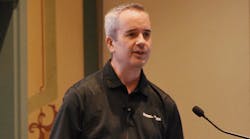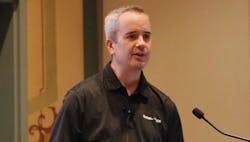How automation technology can fill employee gaps
“Automation and Orchestration software has many out-of-the-box tools to help users employ MES with Plex, such as pre-built screens and logic, sample objects, and a code-free environment to meet users’ specific needs.” Plex Systems’ Tony Kaczmarek suggested automation to ease the worker dearth.
Multiple factors are piling up to worsen the U.S. and international workforce shortage and likely extend it for years. Luckily, automation can help fill some of these personnel gaps until the slow process of educating more students in schools and training recruits by employers can recover some of these shortfalls.
“We’re hearing about companies facing 20-40% shortfalls in employees throughout their organizations,” says Tony Kaczmarek, vice president of product management at Plex Systems, a Rockwell Automation company. “This will continue to be a big issue for years to come.”
There are an estimated 2.1 million open positions that may prove difficult to fill by 2030 due to persistent skills gaps, according to recent analysis by Deloitte of data from the U.S. Bureau of Labor Statistics. This is because about 4 million manufacturing jobs will need to be filled during 2020-2030, including 1.5 million new jobs due to expected growth in manufacturing and 2.5 million open jobs due to retirements, but the analysis estimates that only 1.9 million of these jobs are likely to be filled.
“Retirements have been increasing for years, and the need for new skills to handle new technologies have been growing, too,” added Kaczmarek. “These created huge gaps in the workforce, but they’re accelerating even more because of the pandemic and recent supply-chain issues. Plus, added regulatory compliance, quality and track-and-trace requirements for products are also piling on demands for even more skills.
“At the same time, finding just the right person for a position is more difficult than ever. Due to these issues, it’s also harder to find the time to innovate, deliver products on time, compete and grow, while trying to keep operators, technicians and other employees happy, especially when many of them have to work 10-hour shifts and/or on weekends. Everything just keeps piling on,” said Kaczamarek, who presented “Combatting the Skilled Workforce Shortage With Process Automation” at ROKLive 2022 in Orlando, Fla.
Automation to the rescue
To relieve the pressure of multi-factor workforce shortages, Kaczmarek reported that Plex has been helping customers for 20 years with an equally varied selection of remedies. He explained that processes and workplaces can be improved with automation, selective augmentation, communication and connection, training and a larger labor pool. In general, automation includes preparing to operate with fewer people, offloading mundane, repetitive and non-value-added processes and gaining uncompromised accurate and precise data.
“In the Plex ecosystem, we’re also seeing more reskilling of workers to take on new roles and fill some of these workforce gaps. This can include database support staff taking on some business analyst tasks,” said Kaczmarek. “For instance, a welding line using our Mach2 software recently went from six to two people, but they implemented a virtual poka-yoke system to ensure correct actions in their clamping and other procedures, and this let them transition from mostly recording production events to performing other useful tasks.” Poka-yoke is a Japanese method for using an automatic procedure or device to prevent accidental errors by users in real-time.
Mach2, newly rebranded as Plex Automation and Orchestration, lightens potentially overwhelming workloads by using data and triggers to re-normalize operations. For example, it may combine two human-machine interfaces (HMIs) into one display to simplify the input that operators must take in. The company also seeks to alleviate users’ concerns about excessive oversight.
“Many operators are worried that Big Brother is taking over, but what’s really happening is an effort to empower them. The software shows them added evidence and more in-depth information, so they have a better chance of resolving problems, instead of everyone continuing to blame each other,” explained Kaczmarek. “Also, simplifying these functions democratizes and widens the available labor pool because more people can perform them.”
Plex MES Automation and Orchestration software is part of Plex’s Smart Manufacturing Platform, which consists of its manufacturing execution system (MES), manufacturing automation, quality management system (QMS), supply chain planning (SCP) and business operations sections. So far, the software is installed in about 8,500 workstations at 30-50 companies.
“Using data from just one cycle of a customer’s operating process, we can build an automation and orchestration solution,” said Kaczmarek. “This automation covers part counting, production and scrap recording, documenting serialized pieces, lineside labeling, machine state and status updates, job setup and data collection. The software can use this information to do a ton of things, but mainly identify the pain that a user’s process is experiencing, address it with a robust SCADA (supervisory control and data acquisition) system and employ a no-code environment to add value.”
Augment and communicate
In the operator augmentation realm, MES Automation and Orchestration software seeks to resolve other pain points, such as OEM requirements, validation tasks and workflow issues.
“We can make sure users are following the right procedures by employing pick-to-light, vision systems or augmented reality (AR) tools, which can show them where components need to go,” added Kaczmarek. “These are similar to the poka-yoke system at the welding application, which also verifies that users are completing all their necessary steps outside the light curtain and then showing parts produced inside the light curtain. In packout applications, operator augmentation covers automating machine counts and recording, barcode readers, small and mixed lots, point-of-use lineside labeling and weigh scales. There’s a lot of variability and configurability in these applications, which make it useful to capture configurability KPIs.”
To connect and communicate faster and more accurately—and improve trust—MES Automation and Orchestration software replace physical whiteboards and other old tools with area overviews, digital whiteboards, operator interfaces, performance dashboards, source materials depletion, job and container completion forecasts, operator feedback, bulletins and bigger screens renderings on tablets PCs, smartphones and laptops.
“Automation and Orchestration has many out-of-the-box tools to help users and machines employ MES with Plex, such as pre-built screens and logic, sample objects and a code-free environment to meet users’ specific needs,” added Kaczmarek. “These include production and scrap recording, lineside labeling, job and work-center setup, work center performance, timeline ribbons, machine states, performance KPIs and connections to asset performance management (APM) for deeper drives into outcomes and better insights. For instance, Hatch used these tools to achieve a 20% improvement in production throughput due to greater equipment and operator efficiency.”
The editors of Control, Control Design and Smart Industry are reporting live from ROKLive 2022 in Orlando, Florida, to bring you the latest news and insights from the event. When the event comes to a close, the best, most important coverage will be compiled into a report by the editors.
Register now to pre-order the report and be among the first to receive it in your inbox.






